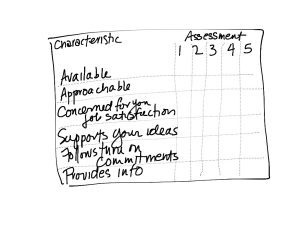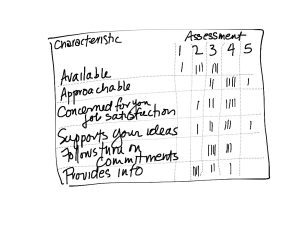Managers–like everyone else–need feedback to know how and where to adjust their actions. Managers may receive feedback from their managers. That’s necessary, but not sufficient. In addition to hearing how things look from above, managers need feedback from the people they support.
In general, anonymous feedback in the workplace doesn’t work. It destroys trust, and doesn’t give the opportunity for followup, clarification, or problem-solving.
Except…
Managers have power over the people who report to them. They rate, promote, fire, and influence careers in many ways. Therefore, it takes extra effort to receive clear and honest feedback regarding manager performance.
When I ask knowledge workers why they don’t give their managers feedback, here’s a sample of what I hear:
- If I criticize him, I’ll see the effects when it comes to my review.
- Feedback is a one-way street with my manager.
- It’s not my job.
- Last time I tried, I paid for it.
In short, people fear retribution.
Yet, it is essential for people in management roles to understand how their actions affect the people who report to them.
Facilitating Upward Feedback
Sometimes the only way feedback gets up the chain is through a process that anonymizes individual responses. Ideally, the process includes open discussion of the results. However, I’ve encountered cases where it takes a neutral, outside facilitator to create sufficient safety.
When trust in between is low, rebuilding trust is the first priority. Asking for feedback can be part of that—if it’s handled carefully.
Even when with a foundation of trust, power differences create an obstacle to honest feedback.
However, when a manager establishes that he is open to feedback, will act on feedback, and does not retaliate, people may become more willing to give direct feedback.
Willingness is the 0th Step
Before starting, a manage must be really willing to hear the feedback and act on it.
Going through this exercise and not making any changes spawns cynicism. Gathering data and then punishing people shatters trust.
Managers may hear information that is surprising or unsettling. They may learn that other people don’t see them as they see themselves. They may find out that others’ perceptions don’t match the managers intentions. It’s okay to be hurt and acknowledge hurt. Defensiveness, sulking, and other sideways displays will clog the information pipeline.
The baseline for the process is willingness to hear uncomfortable information and take at least some action.
For managers who can’t affirm that, it would be useful to reflect on why that is. As a starting point, consider hiring a coach or taking a management style assessment to gain perspective on others’ perceptions.
The Process
Here’s a process I’ve used and taught others to use.
Set aside at least two team meetings for the feedback process. Overall, the process takes about a week.
Meeting #1: Identify the Characteristics and Behaviors That Matter
Introduce the process. Provide an overview and explain how the data will be used. Ask for help. After all, managers do need information about how their actions are supporting (or impeding) others’ work.
Ask the group to individually brainstorm the qualities and behaviors most important to them. I tend to use stickies to do an affinity sort. Have the group attach a descriptive name to each affinity group. Most groups end up with five to seven groupings.
After the meeting, create a short survey to collect data on the identified categories. Framing the scale for the survey matters.
I’ve use a scale like this one:
1=Behavior in this area is getting in our way
3=Could do more/differently here
5=Keep doing what you are doing
Create a scale that doesn’t express judgement. Avoid terms such as “poor” or “outstanding.” Use wording that focuses on behaviors, not an assessment of goodness or worthiness.
Distribute the survey, and create a way for people to respond anonymously. When rebuilding trust, I recommend having someone in the group or a neutral party do the tally.
Meeting #2: Discuss the Data
Numbers don’t have meaning in and of themselves. They won’t reveal what to consider changing, what to stop doing, or what to continue. But they will help start a discussion.
Vague generalities won’t help. Ask for specific, concrete examples in each categories. For areas where the team would like to see something different, engage in problem-solving and identify several possible options.
Here’s what one manager’s data looked like:
Problem Solve
One manager responded to a low number for “availability” without asking for more specific information. She instituted office hours and handed out her home phone number.
But that wasn’t what her staff wanted. They felt dismissed when she took phone calls and checked email during one-on-one meetings. Office hours with the same interruptions wouldn’t help.
For areas at the low end of the scale, ask for one or two things alternatives that will increase effectiveness.
It is possible that something a manager feels critical to the job is driving other people crazy. In that case, explain the need or goal behind the behavior and look for other ways to accomplish the goal.
One manager was annoying his team by inserting himself into technical discussions and decisions. The group felt they should have a bigger voice. He explained his concern. He feared they lacked context and might make a decision that would work short-term but would be detrimental long-term. Once the team understood his concern, they were able to move into problem-solving. They agreed that the manager would provide context, set boundaries, and be clear on whether he was looking for a recommendation or a final decision.
Flex Where You Can
Chances are that some categories some people will be please and others displeased. In some cases, you can have it both ways. For example, say one person feels weekly check-ins are too frequent and another appreciates the interest and attention. Adjust to individual preferences (assuming there’s no overriding issue ). In other cases, abide by the adage, “You can please some of the people some of the time, but you can’t please all of the people all of the time.”
Clarify Interpretations
One manager learned that people inferred that she didn’t like to hear bad news. They thought this because she furrowed her brow and scrunched up her face when people informed her of problems. They thought she was mad at them. This manager could probably not change how her face looked when she was really concentrating on a problem. But she could catch herself scrunching and explain she wasn’t angry, just thinking hard.
Rebuilding Trust
If the trust level is too low for this method, consider having a neutral party facilitate the process. Put it in the context of rebuilding trust. A neutral party can help ensure that people feel free to state their perceptions. They can also help with absorbing the feedback and shaping new responses. Asking for feedback can be the first step in repairing relationships.
Manage Expectations
Whether starting from a position of high trust or low trust, reasonable people don’t a complete overnight change. Just as a reasonable manager wouldn’t expect someone to make 15 behavioral changes in the course of the week. Ask what is most important to focus on. And then follow through and make adjustments.
I’ve describing this process in the context of a manager getting feedback. I’ve seen a similar process involving a group member. Usually, these are situations where someone’s perception of their own behavior/performance is radically different from how others see it. That sort of intervention usually involves a neutral 3rd party with experience and training in some sort of counseling.











I enjoyed this post, as I too believe that feedback from both your manager, and the people below you is crucial to understanding your current performance and abilities. Too often I have worried myself, that I am not providing enough to my team of staff, and have asked them on many occasions if there is anything they would like to change or perhaps do differently. Most of the time, shrugged shoulders, or half-answers are given, with no real information which can be acted upon.
I like your solution to this issue, and would certainly feel comfortable in implementing in relevant future scenarios.
Thanks for an enjoyable read,
TheLeanThinker